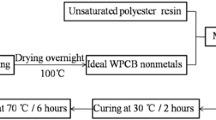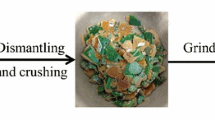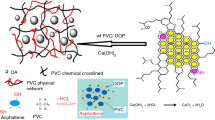Abstract
In the previous study, organic solvent dimethyl sulfoxide (DMSO) could effectively delaminate waste printed circuit boards (WPCBs) by swelling cured brominated epoxy resins (CBER). To find more organic solvents which can swell CBER, the total and three-dimensional Hansen solubility parameters (3d-HSP) of CBER in WPCBs were calculated by a group contribution method and an equilibrium swelling degree method. During testing equilibrium swelling degree, seventeen industrial common organic solvents were used to swell CBER in WPCBs. The results were that the total solubility parameter of CBER (δ t) was 24.6–26.4 (J/cm3)1/2, and 3d-HSP were that dispersion force (δ d) was 20.9(J/cm3)1/2, intermolecular dipole interaction force (δ p) was 11.1(J/cm3)1/2, and hydrogen-bonding force (δ h) was 11.6 (J/cm3)1/2. Then, 3-cresol was chosen to swell CBER in WPCBs according to its total and 3d-HSP. Result indicated that the WPCBs were delaminated completely in 3-cresol solvent. Finally, experimental results and theoretical analysis showed that the glass transition temperature (Tg) and solubility parameter of CBER were two very important factors for choosing organic solvents to delaminate the WPCBs. In addition, interaction forces of molecular functional groups between CBER and organic solvents were also an influence factor.








Similar content being viewed by others
References
Long LS, Sun SZ, Zhong S, Dai WC, Liu JY, Song WF (2010) Using vacuum pyrolysis and mechanical processing for recycling waste printed circuit boards. J Hazard Mater 177(1–3):626–632
Hadi P, Xu M, Lin CSK, Hui CW, McKay G (2015) Waste printed circuit board recycling techniques and product utilization. J Hazard Mater 283:234–243
Zhu P, Chen Y, Wang LY, Qian GR, Zhang WJ, Zhou M, Zhou J (2013) Dissolution of brominated epoxy resins by dimethyl sulfoxide to separate waste printed circuit boards. Environ Sci Technol 47(6):2654–2660
Zhu P, Chen Y, Wang LY, Zhou M, Zhou J (2013) The separation of waste printed circuit board by dissolving bromine epoxy resin using organic solvent. Waste Manag 33(2):484–488
Sepúlveda A, Schluep M, Renaud FG, Streicher M, Kuehr R, Hagelüken C, Gerecke AC (2010) A review of the environmental fate and effects of hazardous substances released from electrical and electronic equipments during recycling: examples from China and India. Environ Impact Assess Rev 30(1):28–41
Czégény Z, Jakab E, Blazsó M, Bhaskar T, Sakata Y (2012) Thermal decomposition of polymer mixtures of PVC, PET and ABS containing brominated flame retardant: formation of chlorinated and brominated organic compounds. J Anal Appl Pyrolysis 96:69–77
Sadat-Shojai M, Bakhshandeh GR (2011) Recycling of PVC wastes. Polym Degrad Stab 96(4):404–415
Damian C, Espuche E, Escoubes M (2001) Influence of three ageing types (thermal oxidation, radiochemical and hydrolytic ageing) on the structure and gas transport properties of epoxy-amine networks. Polym Degrad Stab 72(3):447–458
Sun ML (2003) Application principle and technology of epoxy resin (Chinese version). Machinery Industry Press, Beijing, pp 478–482
Guang JR, Qing HR (2007) High polymer physics (Chinese version). Chemical Industry Press, Beijing, p 61
Hansen CM (2004) 50 Years with solubility parameters—past and future. Prog Org Coat 51:77–84
Hansen CM (1967) The three dimensional solubility parameter and solvent diffusion cofficient. Danish Technical Press, Copenhagen
Arends D, Schlummer M, Mäurer A, Arends D, Mäurer A (2012) Removal of inorganic colour pigments from acrylonitrile butadiene styrene by dissolution-based recycling. J Mater Cycles Waste Manag 14(14):85–93
Grause G, Hirahashi S, Toyoda H, Kameda T, Yoshioka T (2015) Solubility parameters for determining optimal solvents for separating PVC from PVC-coated PET fibers. J Mater Cycles Waste Manag 1–11. doi:10.1007/s10163-015-0457-9
Nielsen TB, Hansen CM (2005) Elastomer swelling and Hansen solubility parameters. Polym Test 24(8):1054–1061
Liu GY, Hoch M, Wrana C, Kulbaba K, Qiu GX (2013) A new way to determine the three-dimensional solubility parameters of hydrogenated nitrile rubber and the predictive power. Polym Test 32(6):1128–1134
Levin M, Redelius P (2008) Determination of three-dimensional solubility parameters and solubility spheres for naphthenic mineral oils. Energy Fuels 22:3395–3401
Sato T, Araki S, Morimoto M, Tanaka R, Yamamoto H (2014) Comparison of Hansen solubility parameter of asphaltenes extracted from bitumen produced in different geographical regions. Energy Fuels 28(2):891–897
Krevelen DW (1981) Properties of polymers: their estimation and correlation with chemical structures (Chinese version). Science Press, Beijing, p 102
Liu DZ, Wang ZQ (2008) Solubility parameter and its application in coatings industry (Chinese version). Ocean Press, Beijing, p 102–112
Fraga F, Castro-Diaz C, Rodriguez-Nuñez E et al (2003) Physical aging for a epoxy network diglycidyl ether of bisphenol A/m-xylylenediamine. Polymer 44(19):5779–5784
Auvergne R, Caillol S, David G, Boutevin B, Pascault JP (2014) Biobased thermosetting epoxy: present and future. Chem Rev 114(2):1082–1115
Le Magda M, Dargent E, Youssef B, Guillet A, Idrac J, Saiter J-M (2012) Thermal properties evolution of PCB FR4 epoxy composites for mechatronic during very long ageing. Macromol Symp 315(1):143–151
Lee HS, Jeong JH, Hong G, Cho HK, Baek BK, Koo CM, Hong SM, Kim J, Lee YW (2013) Effect of solvents on de-cross-linking of cross-linked polyethylene under subcritical and supercritical conditions. Ind Eng Chem Res 52:6633–6638
Adamson MJ (1980) Thermal expansion and swelling of cured epoxy resin used in graphite/epoxy composite materials. J Mater Sci 15:1736–1745
Loos AC, Springer GS (1981) In: Springer GS (ed) Environmental effects on composite materials. Technomic Publishing Co, Westport, p 34
Reichardt C (1987) Solvent effects in organic chemistry (Chinese version). Chemical Industry Press, Beijing, p 14
Acknowledgements
The authors are supported by Program for Innovative Research Team in University (No. IRT13078), Shanghai Cooperative Centre for WEEE Recycling and the Innovation Program of Shanghai Municipal Education Commission (14YZ002).
Author information
Authors and Affiliations
Corresponding author
Rights and permissions
About this article
Cite this article
Zhu, P., Yang, Y.Z., Chen, Y. et al. Influence factors of determining optimal organic solvents for swelling cured brominated epoxy resins to delaminate waste printed circuit boards. J Mater Cycles Waste Manag 20, 245–253 (2018). https://doi.org/10.1007/s10163-016-0574-0
Received:
Accepted:
Published:
Issue Date:
DOI: https://doi.org/10.1007/s10163-016-0574-0




